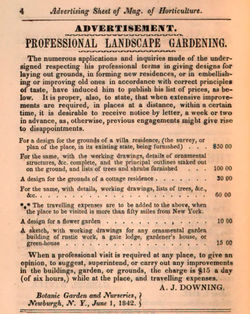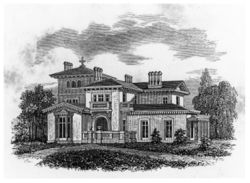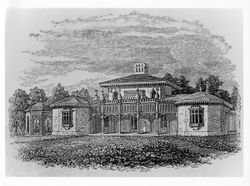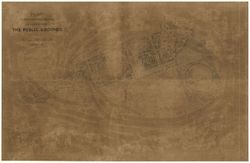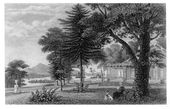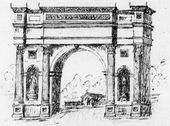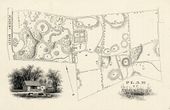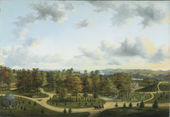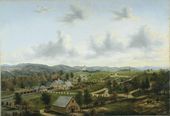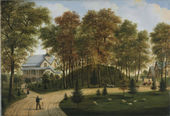Andrew Jackson Downing
Overview
Birth Date: October 31, 1815
Death Date: July 28, 1852
Birth Location: Newburgh, NY
Role: Landscape designer, Nurseryman
Used Keywords: Ancient style, Avenue, Border, Botanic garden, Bridge, Canal, Cemetery/Burying ground/Burial ground, Common, Fence, Geometric style, Lake, Landscape gardening, Lawn, Meadow, Modern style/Natural style, Park, Picturesque, Pleasure ground/Pleasure garden, Seat, Statue, Vase/Urn, View/Vista, Walk, Wood/Woods
Other resources: Library of Congress Authority File; Getty ULAN; The Cultural Landscape Foundation; American National Biography; Smithsonian Gardens - The Downing Urn; Columbia University Libraries Online;
Andrew Jackson Downing (October 31, 1815—July 28, 1852) helped steer American popular taste in landscape and garden design toward more natural, picturesque modes in the middle of the 19th century [Fig. 1]. In addition to “rural design,” he promoted the professionalization of landscape design and reached a growing middle-class audience through his influential books and periodicals. Concerned about the effects of overcrowded, industrialized cities, Downing advocated for the development of suburbs as well as the creation of public parks. At the time of his death at age thirty-six, he was at work on ambitious plans for Public Grounds in Washington, DC, on the present site of the National Mall.
History
Andrew Jackson Downing, a leading nurseryman, landscape designer, and author in the mid-19th-century United States, was born in 1815 in Newburgh, New York—where he spent his entire life and career—to nurseryman Samuel Downing (d. 1822) and his wife, Eunice Bridge Downing (d. 1838). A. J. Downing showed an early interest in horticulture, joining the family nursery business in 1831 while still a teenager.[1] He took over his brother Charles’s share of the business soon after their mother’s death in 1838 and named the establishment Botanic Garden and Nurseries (also known as Highland Gardens or Highland Nurseries) [Fig. 2]. Downing soon began to market himself primarily as a landscape designer, advertising “Professional Landscape Gardening” services in the 1842 volume of C. M. Hovey's Magazine of Horticulture [Fig. 3].[2] Throughout this period, he also published extensively on horticulture, landscape design, and architecture. Downing sold Botanic Garden and Nurseries in 1846, as landscape design and writing activities started to occupy more of his attention.[3]
Between 1841 and 1850, Downing published four books that had a significant and enduring impact on the fields of landscape design, horticulture, and architecture in the United States. A Treatise on the Theory and Practice of Landscape Gardening, Adapted to North America—Downing’s first book and the first treatise on landscape gardening published in the United States—lays out “leading principles” and “practicable methods” by which land owners could embellish their rural residences. For Downing, such embellishments were of great civil and social import; he claimed that home improvements could “increase local attachments . . . strengthening [the proprietor’s] patriotism and making him a better citizen.” In the preface, Downing also acknowledged that he drew heavily on European—especially British—authors when developing his principles of landscape design, adapting their recommendations to suit “this country [the United States] and the peculiar wants of its inhabitants” (view text).
Although he did not view English landscapes in person until the end of his life, when he traveled abroad for the first and only time in 1850, British landscape theories of the picturesque played a significant role in the formulation of Downing’s landscape design principles. These writings include especially those of Edmund Burke (1729—1797), Sir Uvedale Price (1747—1829), Humphry Repton (1752—1818), John Claudius Loudon (1783—1843), and John Ruskin (1819—1900).[4] By the time Downing published the second edition of his Treatise in 1844, he was arguing more forcefully for the “great advantage” of the picturesque, writing in a passage not included in the first edition, “The raw materials of wood, water, and surface, by the margin of many of our rivers and brooks, are at once appropriated with so much effect, and so little art, in the picturesque mode; the annual tax on the purse too, is so comparatively little, and the charm so great!” (view text). Downing thus became a champion of landscapes in the natural style during the middle of the 19th century, helping to steer American popular taste away from the more geometric modes that dominated throughout the 18th and early 19th centuries. According to David Schuyler, “Downing interpreted this progression from classic to romantic not simply as a change in stylistic preference but as a reflection of the nation’s evolution from a pioneer condition to a more advanced state of civilization.”[5]
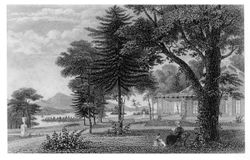
Between the publication of the first two editions of the Treatise, Downing altered his recommendations on the use of native versus exotic plants. In 1841, while he still made his living primarily as a nurseryman, Downing warned estate owners not to replicate the woodlands of the surrounding Hudson Valley countryside and instead advocated the use of non-local North American and Eurasian species (view text). Philip J. Pauly has argued that financial decisions may have informed Downing’s advice, noting that gardeners who used exclusively local plants “would generate little business for nurserymen like Downing.” By 1844, when Downing was better known as an author and designer than as a nurseryman, he embraced the use of local landscape features—especially “the raw materials of wood, water, and surface”—in picturesque landscape design. According to Pauly, this shift may have been rooted in nativist attitudes as well as design considerations. Likely concerned about increased professional competition with the rise of immigration during this period, Downing added a “Note on Professional Quackery” to the appendix of the 1844 edition of his Treatise, in which he singled out “a foreign soi-disant landscape gardener” who, in Downing’s view, had “completely spoiled the simply grand beauty of a fine river residence” by “only follow[ing] a mode sufficiently common and appropriate in a level inland country, like that of Germany. . . but entirely out of keeping” with the character of local landscape (view text).[6]

While preparing the manuscript for the first edition of his Treatise in 1838, Downing enlisted the help of the New York City architect Alexander Jackson Davis (1803—1892) to illustrate the text—a collaboration that would continue throughout the remainder of Downing’s career [Fig. 4]. Downing, who, Robert Twombly argues, was “not a polished draftsman,” provided Davis with sketches that Davis “put into proper form for engraving and publication.”[7] Because of advances in printing technologies, Downing was able to integrate images into his texts easily and inexpensively, making his well-illustrated publications affordable to a growing middle-class audience. He illustrated diverse examples of architectural and landscape designs in the Treatise, ranging from residences of various sizes to small garden embellishments and ideal arrangements of plants and trees [Figs. 5—8]. Caren Yglesias has argued that “The images satisfied his audience’s visual appetite and allowed readers to imagine their own tasteful homes and gardens,” using the accompanying texts as a guide.[8] Downing’s Treatise was immediately popular after its publication; he published at least two additional editions of the text during his lifetime (in 1844 and 1849), and the Treatise remained in print until the publication of its tenth edition in 1921.[9]
In 1842 Downing and Davis collaborated on a second book, Cottage Residences, which proposed integrated designs for modest dwellings and gardens that targeted cost-conscious, middle-class consumers (view text). Downing’s third book, The Fruit and Fruit Trees of America, published in 1845, drew on his experience as a nurseryman and offered practical advice on planting orchards.[10] Downing’s fourth and final book, The Architecture of Country Houses, published in 1850, again provided practical advice for homeowners and proposed designs for freestanding houses. In the preface, Downing argued for the “moral influence” and social benefits of having “good houses.” He wrote, “when smiling lawns and tasteful cottages begin to embellish the country, we know that order and culture are established. . . . the interest manifested in the Rural Architecture of a country like this, has much to do with the progress of its civilization” (view text). Unlike Downing’s previous architectural tome, The Architecture of County Houses provided no specific advice on landscape gardening.[11]
Downing also published numerous articles in horticultural periodicals throughout his career. In 1832, at age sixteen, he contributed his first essay to a regional horticultural magazine (view text).[12] In July 1846, following the successful release of his first three books, he became the founding editor of a new monthly journal started by Luther Tucker (1802—1873) in Albany, New York, Horticulturist and Journal of Rural Art and Rural Taste, a position that he held for six years.[13] Downing published seventy-four monthly editorials covering a wide range of topics in the Horticulturist and, as with his books, worked with Davis to illustrate his articles. Downing devoted much of his writing to the topics of rural improvement and land management. His advocacy for such issues extended beyond his role as editor, however. As a champion for public agricultural education, Downing helped develop a plan for a state agricultural college in New York between 1849 and 1852 that, much to his disappointment, was never realized. He had long argued for the importance of institutions of public learning, claiming that they were essential for the development of American society and republican virtues. To this end, throughout the late 1830s and early 1840s, Downing helped establish the Newburgh Library Association (1835), the Newburgh Lyceum (1837), and the Horticultural Association of the Valley of the Hudson (1838).[14]
In addition to advocating for rural improvements, Downing also addressed the importance of urban and suburban public parks and gardens, arguing that such spaces would aid in the cultivation of moral and civic virtues in the American public. Such notions gained currency throughout the 1840s and 1850s, a period in which public gardens were increasingly conceived to serve both recreational and edifying functions.[15] Downing was a significant proponent of this view. In his October 1848 Horticulturist editorial entitled “A Talk about Public Parks and Gardens,” for example, Downing wrote that public parks would play an important role “in elevating the national character.” He urged his readers: “Let our people see for themselves the influence for good which [the founding of a public park] would effect, no less than the healthful enjoyment it will afford, and I feel confident that the taste for public pleasure-grounds, in the United States, will spread as rapidly as that for cemeteries has done” (view text).[16] As editor, Downing also published the writing of other important advocates for public parks, including an early essay by Frederick Law Olmsted (1822—1903) entitled “The People’s Park at Birkenhead, Near Liverpool.”[17]
Downing gained a wide audience through his books and editorials in the Horticulturist, but his influence exceeded the readership of such publications as agricultural journals and later generations of pattern-book authors modified, adapted, and widely disseminated Downing’s ideas. Much as Downing had imitated and altered English architectural and landscape practices to suit an American audience, according to Schuyler, “[t]he publication of his designs was followed by a process of imitation and modification, an American analogue to the adaptation of English forms he had practiced.”[18] Gardens and buildings that were not designed by Downing but nonetheless owed their forms to Downing’s ideas proliferated throughout the United States during the middle of the 19th century.[19]

Few of Downing’s design projects are extant. His first major architectural and landscape design project was Highland Garden (also known as Highland Place), Downing’s own Tudor-style house in Newburgh that he designed in 1838, around the time of his marriage to Caroline Elizabeth De Windt (1815—1905).[20] Although “the Newburgh villa was. . . an accomplished work,” Adam W. Sweeting argues that Downing, only twenty-four years old and with no formal architectural training, most likely “relied on an English pattern book when designing his house.” Initially, Downing’s nursery business took up much of the property near the residence, limiting the scope of his landscape design. However, after selling the nursery in 1846, he developed the landscape surrounding his home to resemble a picturesque English estate [Fig. 9].[21] Although he was not a trained architect, as his national reputation grew, Downing received requests to design private and public buildings. According to Schuyler, between 1846 and 1850, Downing usually passed these commissions on to Davis. However, there are at least three projects from this period on which Downing and Davis worked together on the architectural design: Angier Cottage in Medford, Massachusetts; the design for the proposed New York State Agricultural College; and the plans for the entrance gate and chapel for the Cemetery of the Evergreens in Brooklyn, New York.[22] While traveling in London in 1850, Downing met the young English architect Calvert Vaux (1825—1895) and convinced Vaux to move to Newburgh so that he could pursue additional architectural projects with Vaux’s assistance. From September 1850 until July 1852, Vaux worked with Downing—initially in Downing’s employ before the two formed a professional partnership, “Downing & Vaux, Architects.” Of their many collaborations, Springside, Matthew Vassar’s (1792—1868) one-hundred-acre estate in Poughkeepsie, New York, is one of the few that survives largely intact [Fig. 10].[23]
Downing and Vaux’s most significant project was the 1850—52 plans for a Public Grounds in Washington, DC, located in the area that now constitutes the National Mall. At the behest of Smithsonian Secretary Joseph Henry (1797—1878), financier William Wilson Corcoran (1798—1888), Mayor Walter Lenox (1817—1874), and Commissioner of Public Buildings Ignatius Mudd (d. 1851), President Millard Fillmore (1800—1874) invited Downing to create a public park of approximately 150-acres, extending east-west between the foot of the United States Capitol Grounds and the Potomac River (then near the Washington Monument) and north-south between the river and the White House.[24] Therese O’Malley has argued that improvements to Washington’s public spaces during these years should be understood as an effort “to counteract the reputation of an unimproved capital and a center of slavery.” Following the abolition of the slave trade (although not slavery itself) in the city in 1850 and the removal of slave pens across from the Smithsonian Institution’s new building, Downing’s plans to redevelop the site bolstered the federal government’s attempts to present “the appearance of democracy” and “strengthen physical symbols of the national image” through the development of the city’s public spaces.[25]
Downing’s plan divided the Public Grounds into six sections [Fig. 11]. The U.S. Capitol Grounds would connect to the national Botanic Garden, located on the site of the former Columbian Institute, and then, continuing westward, to “Fountain Park,” the “Smithsonian Pleasure Grounds,” “Evergreen Garden,” and “Monument Park” (the area surrounding the Washington Monument). A suspension bridge [Fig. 12] would cross the Tiber Canal, connecting the “Monument Park” to the circular lawn of the “Parade or President’s Park” and then the “President’s Grounds” located adjacent to the White House. Downing proposed a marble triumphal “President’s Arch” [Fig. 13], located at the end of Pennsylvania Avenue near the “President’s Grounds,” to mark the main entrance to the Public Grounds from the city. With the exception of the “Evergreen Garden” and the “Parade or President’s Park,” Downing intended for the Public Grounds to be landscaped in what he called the natural style, with curving walks and picturesque arrangement of trees and artificial lakes [Fig. 14].[26] In accordance with his views on the functions of public parks noted above, Downing’s goals for the redevelopment of the National Mall were, in part, pedagogical. He wrote that he hoped the Public Grounds would “become a Public School of Instruction in every thing [sic] that relates to the growth and culture of trees” (view text).
President Fillmore approved the western portion of Downing’s plan in April 1851, and the clearing, draining, and grading of the area around the Smithsonian began almost immediately. However, Downing’s life and career were tragically cut short when, on July 28, 1852, the steamship Henry Clay, on which Downing was traveling between Newburgh and New York City, caught fire and he drowned. In his memory, the so-called Downing Urn was sponsored by the American Pomological Society, designed by Vaux, and sculpted in marble by Robert E. Launitz (1806—1870). Erected in 1856, it was the first monument to be completed on the National Mall.[27]
Through his writing and landscape projects, Downing left a legacy that continued to shape landscape design—and especially the urban park movement—in the United States long after his death. As designers of New York City’s Central Park, Vaux and Olmsted acknowledged that Downing’s design principles inspired their 1857—58 plan for the urban park.[28] In 1889 Vaux and Olmsted joined forces again to plan the Andrew Jackson Downing Memorial Park, which was dedicated in Newburgh, New York, to the memory of their friend and collaborator.[29]
—Lacey Baradel
Texts
- Downing, Andrew Jackson, September 1832, “Rural Embellishments” (2012: 144)[30]
- “In this age of improvement, perhaps nothing is advancing more rapidly, though to many imperceptibly, than the science of Horticulture. Our native forests are fast disappearing, the luscious apple and the melting peach now occupy the places once tenanted by worthless crabs and thorns, and the floral and pomonal treasures of the four continents bloom and flourish in many a spot which had long been overshadowed by ancient oak and elm.
- “The eye of an observing person is constantly reminding him of the rapid increase of costly and beautiful mansions, the abode of the wealthy farmer or the retreat of the retired citizen; and a few remarks on the rural embellishment of these are my principle reason for troubling you with this communication. That branch of horticulture called landscape gardening is, as yet, completely in its infancy among us; in fact, many—far too many—of our landed proprietors who are actively engaged in giving a character as to the appearance of their estates have but a feeble knowledge of the existence, much less the practice, of such an art.”
- Downing, Andrew Jackson, January 1837, “Notices on the State and Progress of Horticulture in the United States” (Magazine of Horticulture 3: 8)[31]
- “The branch of the art least understood and least practised in the United States is landscape gardening. The modern or picturesque style of laying out grounds is most generally attempted of late, and, we regret to see, in some cases where the geometric would be more in character with the country and the situations. The finest single example of landscape gardening, in the modern style, is at Dr. Hosack’s seat, Hyde Park, and the best specimens of the ancient or geometric style may probably be met with in the neighborhood of Philadelphia.”
- Downing, Andrew Jackson, 1841, Preface to A Treatise on the Theory and Practice of Landscape Gardening, Adapted to North America; . . . (1841: ii—iii)[32]
- “While we have treatises in abundance on the various departments of the arts and sciences, there has not appeared even a single essay on the elegant art of Landscape Gardening. Hundreds of individuals who wish to ornament their grounds and embellish their places, are at a loss how to proceed, from the want of some leading principles, with the knowledge of which they would find it comparatively easy to produce delightful and satisfactory results.
- “In the following pages I have attempted to trace out such principles, and to suggest practicable methods of embellishing our Rural Residences, on a scale commensurate to the views and means of our proprietors. While I have availed myself of the works of European authors, and especially those of Britain, where Landscape Gardening was first raised to the rank of a fine art, I have also endeavoured to adapt my suggestions especially to this country and to the peculiar wants of its inhabitants. . .
- “The love of country is inseparably connected with the love of home. Whatever, therefore, leads man to assemble the comforts and elegancies of life around his habitation, tends to increase local attachments, and render domestic life more delightful; thus not only augmenting his own enjoyment, but strengthening his patriotism and making him a better citizen. And there is no employment or recreation which affords the mind greater or more permanent satisfaction, than that of cultivating the earth and adorning our property.” back up to History
- Downing, Andrew Jackson, 1841, Excerpt from A Treatise on the Theory and Practice of Landscape Gardening, Adapted to North America; . . . (1841: 34—35)[32]
- “A fac-simile imitation of nature in gardening, that is, a scene like wild nature, in which only wild trees, shrubs, and plants, are employed, and which is precisely like wild nature, produces pleasure only as it deceives us, and appears to be nature itself. An artistical imitation, affords pleasure to the mind, not only by the expressions of natural beauty which we discover in it, but by the more novel and choicer forms in which they are displayed, and by the tasteful art apparent in the arrangement. The relative merit of the two may be illustrated, by comparing the first, to the counterfeit of the human figure in wax, which at a short distance may be thought to be real, and the last, to the painted landscape or the marble statue. The two latter are no less imitations of nature, than the former, but they are expressive and elegant imitations only, which are never to be mistaken for the originals, as in the case of the wax figure.
- “One of the chief elements of artistical imitation in Landscape Gardening, being a difference in the materials employed in the imitation of nature from those in nature herself, nothing can be more apparent, than the necessity of introducing largely, exotic ornamental trees, shrubs and plants, instead of those of indigenous growth. Thus, to take the simplest example, if we suppose a lawn of an acre, arranged with groups of trees, the groups composed of lindens, horse-chestnuts and magnolias, where the native forests are only filled with oak and ash trees, the variety of the foliage and blossoms alone, will at once suggest the recognition of art. Borders of rare flowers, and climbing plants,—gravel walks, in the place of common paths or roads,—smooth turf, instead of wild meadow,—elegant vases and architectural ornaments, with many other accessories, bespeaking the presence of tasteful and enlightened mind; all these are the essential characteristics of Landscape Gardening, considered as an art of imitation.” back up to History
- Downing, Andrew Jackson, 1842, Preface to Cottage Residences (1842: ii—iv)[33]
- “. . . I wish to inspire all persons with a love of beautiful forms and a desire to assemble them around their daily walks of life. I wish them to appreciate how superior is the charm of that home where we discover the tasteful cottage or villa, and the well designed and neatly kept garden or grounds, full of beauty and harmony, not the less beautiful and harmonious because simple and limited, and to become aware that these superior forms, and the higher and more refined enjoyment derived from them, may be had at the same cost and with the same labor as a clumsy dwelling, and its uncouth and ill designed accessories. . .
- “The relation between a country house and its ‘surroundings,’ have led me to consider, under the term Residences, both the architectural and the gardening designs. To constitute an agreeable whole, these should indeed have a harmonious correspondence one with the other; and although most of the following designs have not actually be carried into execution, yet it is believed that they will, either entirely or in part, be found adapted to many cases of every day occurrence, or at least, furnish hints for variations suitable for peculiar circumstances and situations.” back up to History
- Downing, Andrew Jackson, 1844, Excerpt from A Treatise on the Theory and Practice of Landscape Gardening, Adapted to North America; . . . (1844: 59—60)[34]
- “Within the last five years, we think the picturesque is beginning to be preferred. It has, when a suitable locality offers, great advantage for us. The raw materials of wood, water, and surface, by the margin of many of our rivers and brooks, are at once appropriated with so much effect, and so little art, in the picturesque mode; the annual tax on the purse too, is so comparatively little, and the charm so great!
- “On the other hand, the residences of a country of level plains, usually allow only, the beauty of simple, and graceful forms; and the larger desmesne, with its swelling hills and noble masses of wood, (may we not, prospectively, say the prairie too,) should always, in the hands of the man of wealth, be made to display all the freeness and beauty of the Graceful school.
- “But there are many persons with small, cottage places, of little decided character, who have neither room, time, nor income, to attempt the improvement of their grounds fully, after either of those two schools. How shall they render their places tasteful and agreeable, in the easiest manner? We answer, by attempting only the simple and the natural; and the unfailing way to secure this, is by employing only trees and grass. A soft verdant lawn, and a few forest or ornamental trees, well grouped, give universal pleasure—they contain in themselves, in fact, the basis of all our agreeable sensations in a landscape garden—(natural beauty, and the recognition of art,) and they are the most enduring sources of enjoyment in any place.”
- Downing, Andrew Jackson, 1844, Excerpt from “Note on Professional Quackery,” Appendix IV in A Treatise on the Theory and Practice of Landscape Gardening, Adapted to North America; . . . (1844: 493)[34]
- “Landscape Gardening, like all other arts, is not ignorant pretenders of knowledge, who, without a spark of appreciation for the beautiful in nature, boldly undertake to remodel, in what they consider a tasteful and fashionable style, every piece of natural landscape, whether of a simple or highly picturesque character. . . We have seen one or two examples lately where a froeign soi-disant landscape gardener has completely spoiled the simply grand beauty of a fine river residence, by cutting up the breadth of a fine lawn with a ridiculous effort at what he considered a very charming arrangement of walks and groups of tree. In this case he only followed a mode sufficiently common and appropriate in a level inland country, like that of Germany, from whence he introduced it, but entirely out of keeping with the bold and lake-like features of the landscape which he thus made discordant.” back up to History
- Downing, Andrew Jackson, October 1848, “A Talk about Public Parks and Gardens” (1853: 146)[35]
- “. . . what an important influence these public resorts, of a rational and refined character, must exert in elevating the national character, and softening the many little jealousies of social life by a community of enjoyments. A people will have its pleasures, as certainly as its religion or laws; and whether these pleasures are poisonous and hurtful, or innocent and salutary, must greatly depend on the interest taken in them by the directing minds of the age. Get some country town of the first class to set the example by making a public park or garden of this kind. Let our people once see for themselves the influence for good which it would effect, no less than the healthful enjoyment it will afford, and I feel confident that the taste for public pleasure-grounds, in the United States, will spread as rapidly as that for cemeteries has done. If my own observation of the effect of these places in Germany is worth any thing, you may take my word for it that they will be better preachers of temperance than temperance societies, better refiners of national manners than dancing-schools, and better promoters of general good feeling than any lectures on the philosophy of happiness ever delivered in the lecture-room. In short, I am in earnest about the matter, and must therefore talk, write, preach, do all I can about it, and beg the assistance of all those who have public influence, till some good experiment of the kind is fairly tried in this country.”
- Downing, Andrew Jackson, August 1849, “The Philosophy of Rural Taste” (1853: 105)[35]
- “The corollary to be drawn from this learned and curious investigation of the history of national sensibility and taste, is a very clear and satisfactory one, viz., that as success, in 'the art of composing a landscape' (as Humboldt significantly calls landscape-gardening), depends on appreciation of nature, the taste of the individual as well as that of a nation, will be in direct proportion to the profound sensibility with which he perceives the Beautiful in natural scenery.”
- Downing, Andrew Jackson, 1850, Preface to The Architecture of Country Houses (1850: v—vi)[36]
- “There are three excellent reasons why my countrymen should have good houses.
- “The first, is because a good house (and by this I mean a fitting, tasteful, and significant dwelling) is a powerful means of civilization. A nation, whose rural population is content to live in mean huts and miserable hovels, is certain to be behind its neighbors in education, the arts, and all that makes up the external signs of progress. With the perception of proportion, symmetry, order and beauty, awakens the desire for possession, and with them comes that refinement of manners which distinguishes a civilized from a coarse and brutal people. So long as men are forced to dwell in log huts and follow a hunter’s life, we must not be surprised at lynch law and the use of the bowie knife. But, when smiling lawns and tasteful cottages begin to embellish the country, we know that order and culture are established. And, as the first incentive towards this change is awakened in the minds of most men by the perception of beauty and superiority in external objects, it must follow that the interest manifested in the Rural Architecture of a country like this, has much to do with the progress of its civilization.
- “The second reason is, because the individual home has a great social value for a people. Whatever new systems may be needed for the regeneration of an old and enfeebled nation, we are persuaded that, in America, not only is the distinct family the best social form, but those elementary forces which give rise to the highest genius and the finest character may, for the most part, be traced back to the farm-house and the rural cottage. It is the solitude and freedom of the family home in the country which constantly preserves the purity of the nation, and invigorates its intellectual powers. The battle of life, carried on in cities, gives a sharper edge to the weapon of character, but its temper is, for the most part, fixed amid those communings with nature and the family, where individuality takes its most natural and strongest development.
- “The third reason is, because there is a moral influence in a country house—when, among an educated, truthful, and refined people, it is an echo of their character—which is more powerful than any mere oral teachings of virtue and morality. . .
- “After the volumes I have previously written on this subject, it is needless for me to add more on the purpose of this work. But it is, perhaps, proper that I should say, that it is rather intended to develop the growing taste of the people, than as a scientific work on art. Rural Architecture is, indeed, so much more a sentiment, and so much less a science, than Civil Architecture, that the majority of persons will always build for themselves, and, unconsciously, throw something of their own character into their dwellings. To do this well and gracefully, and not awkwardly and clumsily, is always found more difficult than is supposed. I have, therefore, written this volume, in the hope that it may be of some little assistance to the popular taste. For the same reason, I have endeavored to explain the whole subject in so familiar a manner, as to interest all classes of readers who can find anything interesting in beauty, convenience or fitness of a house in the country.” back up to History
- Downing, Andrew Jackson, June 1850, “Our Country Villages” (Horticulturist 4: 540)[37]
- “The indispensable desiderata in rural villages of this kind [newly planned in the suburbs of a great city], are the following: 1st, a large open space, common, or park, situated in the middle of the village—not less than 20 acres; and better, if 50 or more in extent. This should be well planted with groups of trees, and kept as a lawn. The expense of mowing it would be paid by the grass in some cases; and in others a considerable part of the space might be enclosed with a wire fence, and fed by sheep or cows, like many of the public parks in England.
- “This park would be the nucleus or heart of the village, and would give it an essentially rural character. Around it should be grouped all the best cottages and residences of the place; and this would be secured by selling no lots fronting upon it of less than one-fourth of an acre in extent.”
- Downing, Andrew Jackson, March 3, 1851, “Explanatory Notes,” describing plans for improving the Public Grounds in Washington, DC (quoted in Washburn 1967: 54, 55)[38]
- “My object in this Plan has been three-fold:
- “1st: To form a national Park, which should be an ornament to the Capital of the United States; 2nd: To give an example of the natural style of Landscape Gardening which may have an influence on the general taste of the Country; 3rd: To form a collection of all the trees that will grown in the climate of Washington, and, by having these trees plainly labelled with their popular and scientific names, to form a public museum of living trees and shrubs where every person visiting Washington could become familiar with the habits and growth of all the hardy trees. . .
- “A national Park like this, laid out and planted in a thorough manner, would exercise as much influence on the public taste as Mount Auburn Cemetery near Boston, has done. Though only twenty years have elapsed since that spot was laid out, the lesson there taught has been so largely influential that at the present moment the United States, while they have no public parks, are acknowledged to possess the finest rural cemeteries in the world. The Public Grounds at Washington treated in the manner I have here suggested, would undoubtedly become a Public School of Instruction in every thing that relates to the tasteful arrangement of parks and grounds, and the growth and culture of trees, while they would serve, more than anything else that could be devised, to embellish and give interest to the Capital. The straight lines and broad Avenues of the streets of Washington would be pleasantly relieved and contrasted by the beauty of curved lines and natural groups of trees in the various parks. By its numerous public buildings and broad Avenues, Washington will one day command the attention of every stranger, and if its un-improved public grounds are tastefully improved they will form the most perfect background or setting to the City, concealing many of its defects and heightening all its beauties.”
- Anonymous, September 1852 (Horticulturist 7: 394—95)[39]
- “In the editorship of the HORTICULTURIST, he has shown, perhaps, better than in his other writings, the peculiar fitness of his talents to educate the popular taste for the beautiful in nature and art. The success which has attended this periodical, and the increased attention which is being paid to Landscape Gardening, Horticulture and Rural Decoration, are proof of the beneficial influence of his labors. . . Mr. Downing was not by eminance a theorist. It was not his aim to build castles too grand and lofty for human realization, or to show the power of his intellect by forming conceptions, which imagination only could give being to. The great question with him, was, how much of the really beautiful can be made subservient to the public good? how far can elegance and utility be combined? how much of the spirit of the amateur can be infused into the mass of the rural population? He has answered these questions by his deeds.”
- Anonymous, September 1852, obituaries for A. J. Downing (Horticulturist 7: 430)[40]
- “[From the New York Evening Post]
- “These publications of Mr. Downing, more than any other agency, had worked a change in our style of building, and created a general improvement in taste. He was commissioned, by a large number of gentlemen about to construct private residences, to prepare the designs and lay out the grounds. The evidence of his fine professional accomplishments now meet us in all parts of the country, and his loss is one that will be felt far beyond the bereaved circle of which he was the ornament and pride.”
Images
Anonymous, Ground Plan of a portion of Downing’s Botanic Gardens and Nurseries, in Magazine of Horticulture 7, no. 11 (November 1841): 404.
A. J. Davis, “View in the Grounds at Blithewood,” in A. J. Downing, A Treatise on the Theory and Practice of Landscape Gardening (1849), frontispiece
Henry Gritten, Springside: View of Barn Complex and Gardens, 1852.
Henry Gritten, Springside: View of Gardener's Cottage and Barns, 1852.
Notes
- ↑ Robert Twombly, “Introduction: Architect and Gardener to the Republic,” in Andrew Jackson Downing: Essential Texts (New York: W. W. Norton & Company, 2012), 15—16, view on Zotero
- ↑ See also Twombly 2012, 15, 19, view on Zotero; David Schuyler, Apostle of Taste: Andrew Jackson Downing 1815—1852 (Baltimore: Johns Hopkins University Press, 1996), 74—76, view on Zotero.
- ↑ Twombly 2012, 18—19, view on Zotero; Schuyler 1996, 214, view on Zotero.
- ↑ Adam W. Sweeting notes that, while Downing did not quote Burke and departed from Burke’s theories, in some respects, Downing's characterization of the Beautiful "followed the wording of his English predecessor almost exactly.” Adam W. Sweeting, Reading Houses and Building Books: Andrew Jackson Downing and the Architecture of Popular Antebellum Literature, 1835—1855 (Hanover, NH: University Press of New England, 1996), 19—20, view on Zotero. Caren Yglesias argues that for Downing “the most important theoretical work was Sir Uvedale Price’s An Essay on the Picturesque (1794).” Caren Yglesias, The Complete House and Grounds: Learning from Andrew Jackson Downing’s Domestic Architecture (Chicago: Center for American Places at Columbia College Chicago, 2011), 21, view on Zotero. In 1850 Downing spent three months traveling in England, Paris, and Belgium. He published his impressions in a series of letters in the Horticulturist in 1850—51. Twombly 2012, 21, view on Zotero. Eight of “Mr. Downing’s Letters from England” were published monthly in the Horticulturist between September 1850 (vol. 5, no. 3) and March 1851 (vol. 6, no. 3), and in June 1851 (vol. 6, no. 6).
- ↑ Schuyler 1996, 2, view on Zotero.
- ↑ According to Pauly, Downing was particularly upset that William Backhouse Astor, proprietor of Rokeby, an estate located about ten miles north of Hyde Park, hired Hans Jacob Ehlers (1804—1858), who had been trained in Germany and Denmark, as his landscape gardener in 1841. Philip J. Pauly, Fruits and Plains: The Horticultural Transformation of America (Cambridge, MA: Harvard University Press, 2007), 169—70, view on Zotero.
- ↑ Twombly 2012, 20, view on Zotero. Downing and Davis met through their friend Robert Donaldson (1800—1872) in late 1838 or early 1839. Davis had designed Donaldson’s estate, Blithewood, on the Hudson River. Schuyler 1996, 50, view on Zotero.
- ↑ Yglesias 2011, 4, view on Zotero.
- ↑ The 1849 publication is the fourth edition. The second edition, published in 1844, “included an announcement for a third” edition, which was likely never published. Therese O’Malley, Introduction to A Treatise on the Theory and Practice of Landscape Gardening, Adapted to North America, ed. A. J. Downing, 4th ed. (1849; repr., Washington, DC: Dumbarton Oaks, 1991), x, xn20, view on Zotero. In the first twelve years, Downing’s Treatise sold approximately 9,000 copies. Schuyler 1996, 28, view on Zotero. For an analysis of the various editions of the Treatise edited by Downing, see Judith K. Major, To Live in the New World: A. J. Downing and American Landscape Gardening (Cambridge: MIT Press, 1997), 7—98, view on Zotero.
- ↑ Twombly notes that while The Fruit and Fruit Trees of America was the third book that Downing published, it was actually the second one written. By 1841 Downing was already working on the manuscript. Twombly 2012, 19, view on Zotero.
- ↑ Schuyler 1996, 152, view on Zotero.
- ↑ Downing published the essay as a letter to the editor, signed “X. Y. Z. Newburgh,” in New-York Farmer and Horticultural Repository 5 (September 1832); A. J. Downing, Andrew Jackson Downing: Essential Texts, ed. Robert Twombly (New York: W. W. Norton & Company, 2012), 143—48, view on Zotero.
- ↑ Yglesias 2011, 33, view on Zotero.
- ↑ Twombly 2012, 15, 17, 34, view on Zotero; Schuyler 1996, 18—20, 120, view on Zotero.
- ↑ Therese O’Malley, “‘A Public Museum of Trees’: Mid-Nineteenth Century Plans for the Mall,” in The Mall in Washington, 1791—1991, ed. by Richard Longstreth, Studies in the History of Art, Center for Advanced Studies in the Visual Arts, Symposium Papers, XIV, 2nd ed. (Washington, DC: National Gallery of Art, 2002), xxx, 63, view on Zotero.
- ↑ Twombly 2012, 32, 34—35, view on Zotero. See also A. J. Downing, “Our Country Villages,” Horticulturist and Journal of Rural Art and Rural Taste 4, no. 12 (June 1850): 540—41, view on Zotero.
- ↑ W. [Frederick Law Olmsted], “The People’s Park at Birkenhead, Near Liver[p]ool,” Horticulturist and Journal of Rural Art and Rural Taste 6 (1851): 224–28, view on Zotero.
- ↑ Schuyler 1996, 229, view on Zotero.
- ↑ Twombly 2012, 18, view on Zotero.
- ↑ Caroline Elizabeth De Windt was the granddaughter of John Adams (1735—1826), the second president of the United States, and grand-niece of John Quincy Adams (1767—1848), the sixth president of the United States. When Eunice Bridge Downing died in 1838, Downing and his brother Charles (1802—1885) inherited more than eleven acres. They divided the property evenly, each taking four-and-a-half acres with the remaining two-plus acres held jointly. The house was completed in 1839 on the property that Downing inherited. Twombly 2012, 17, view on Zotero.
- ↑ Sweeting 1996, 128, 131, view on Zotero.
- ↑ Schuyler 1996, 155, view on Zotero.
- ↑ For more information on Downing and Vaux’s commission for Springside, see Schuyler 1996, 164—70, view on Zotero. Other projects include a block of commercial shops and offices in Boston’s waterfront district; the Dudley Observatory in Albany, New York; houses for David Moore and Dr. William A. M. Culbert in Newburgh, New York; Italianate villas for the brothers Robert P. and Francis Dodge in Georgetown, Washington, DC; and Daniel Parish’s villa on Bellevue Avenue in Newport, Rhode Island. See Twombly 2012, 22—23, view on Zotero; Schuyler 1996, 170—74, view on Zotero.
- ↑ Schuyler 1996, 192, view on Zotero.
- ↑ O’Malley 2002, 61—62. See also pages 70—71, view on Zotero.
- ↑ Twombly 2012, 29, view on Zotero; see also Schuyler 1996, 196—198, view on Zotero; and O’Malley 2002, 64—70, view on Zotero.
- ↑ President Fillmore met with Downing in November 1850, and Downing completed a plan in February 1851. Fillmore approved the plans west of 7th Street in April 1851 and the plans east of 7th Street in February 1853, after Downing’s death. Twombly 2012, 23—24, 29, view on Zotero; Schuyler 1996, 199, 201, view on Zotero. In response to the burning of the Henry Clay, the architect Robert Mills wrote to Fillmore in August 1852 to propose a solution to protect steamers and prevent similar tragedies. Mills did not refer to Downing by name in his letter but did note the “hecatomb of victims.” Letter from Robert Mills to President Millard Fillmore, August 6, 1852, quoted in H. M. Pierce Gallagher, Robert Mills, Architect of the Washington Monument, 1781—1855 (New York: Columbia University Press, 1935), 208—9, view on Zotero. See also O’Malley 2002, 76n61, view on Zotero. Since 1989, the urn has been located in the Enid A. Haupt Garden behind the Smithsonian Castle. Smithsonian Gardens website, http://www.gardens.si.edu/our-gardens/downing-urn.html.
- ↑ Twombly 2012, 15, 25, view in Zotero.
- ↑ Yglesias 2011, 22, view on Zotero.
- ↑ A. J. Downing, Andrew Jackson Downing: Essential Texts, ed. Robert Twombly (New York: W. W. Norton & Company, 2012), view on Zotero.
- ↑ A. J. Downing, “Notices on the State and Progress of Horticulture in the United States,” Magazine of Horticulture, Botany, and All Useful Discoveries and Improvements in Rural Affairs 3, no. 1 (January 1837): 1–10, view on Zotero.
- ↑ 32.0 32.1 A. J. Downing, A Treatise on the Theory and Practice of Landscape Gardening, Adapted to North America; with a View to the Improvement of Country Residences. . . with Remarks on Rural Architecture (New York: Wiley & Putnam, 1841), view on Zotero.
- ↑ A. J. Downing, Cottage Residences; or A Series of Designs for Rural Cottages and Cottage-Villas and their Gardens and Grounds. Adapted to North America, (New York: Wiley & Putnam, 1842), view on Zotero.
- ↑ 34.0 34.1 A. J. Downing, A Treatise on the Theory and Practice of Landscape Gardening, Adapted to North America; with a View to the Improvement of Country Residences. . . with Remarks on Rural Architecture, 2nd ed. (New York: Wiley and Putnam, 1844), view on Zotero.
- ↑ 35.0 35.1 A. J. Downing, Rural Essays (New York: George P. Putnam and Company, 1853), view on Zotero.
- ↑ A. J. Downing, The Architecture of Country Houses; Including Designs for Cottages, Farm Houses, and Villas (New York: D. Appleton & Co., 1850), View on Zotero
- ↑ A. J. Downing, “Our Country Villages,” Horticulturist and Journal of Rural Art and Rural Taste 4, no. 12 (June 1850): 537–41, view on Zotero.
- ↑ Wilcomb E. Washburn, “Vision of Life for the Mall,” AIA Journal 47 (March 1967): 52—59, view on Zotero.
- ↑ Anonymous, “Mr. Downing and the Horticulturist,” Horticulturist and Journal of Rural Art and Rural Taste 7, no. 9 (September 1852): 393–97, view on Zotero.
- ↑ “Tributes to the Memory of Mr. Downing,” Horticulturist and Journal of Rural Art and Rural Taste 7, no. 9 (September 1852): 427–30, view on Zotero.


